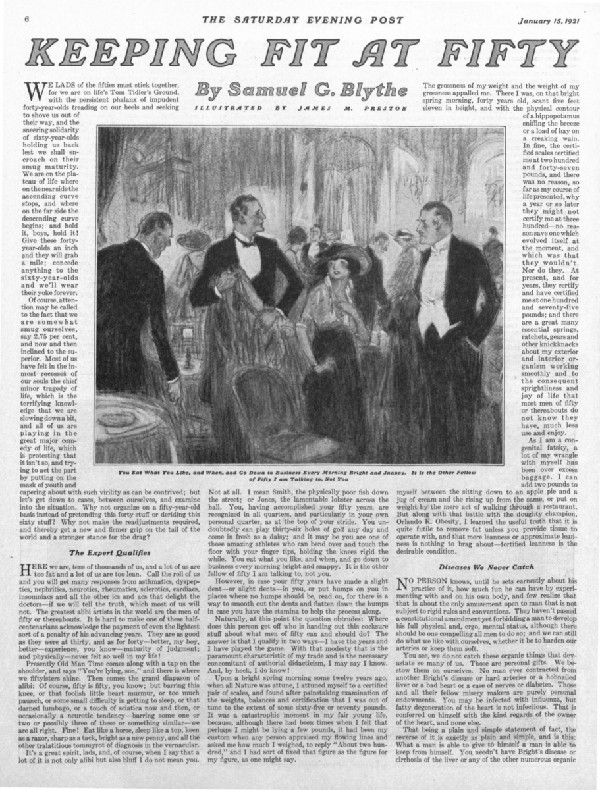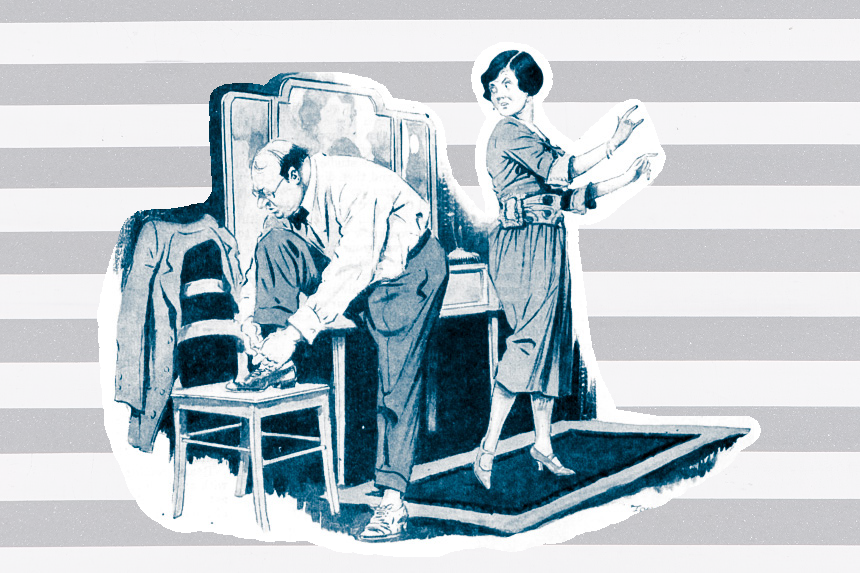Health fads as we know them took shape a century ago. Wellness “experts” — from Bernarr Macfadden in Physical Culture to the Kellogg brothers — gave Americans plenty of new ideas to chew on for cleaner, healthier living, even if they typically involved pricey spa retreats and newfangled diet plans. Vegetarianism was slowly gaining purchase as a way to get “back to Nature.” All the better if you could do it in a health and spirit commune upstate.
As a lifelong reporter, Samuel G. Blythe was skeptical of “food faddists and physical culturists.” In his time at the Post, the New York World, and Cosmopolitan, he had covered the developments of The Great War, foreign policy in Asia, and every major American political event in his adult life. He turned his attention to wellness in an article in the Post 100 years ago (“Keeping Fit at Fifty”) because of his own personal quest to lose weight and get limber as a 52-year-old. Once a self-described “congenital fatsky,” Blythe said that he lost 70 pounds, and other middle-aged Post readers — namely, wealthy men — could do the same if they followed his advice: “I have played the gastronomic gamut and gone the exercise limit, and none of these professors of diet or physical culture have anything on me.”
1. Eat Half of What You Eat Now
Blythe understood the one simple trick for losing weight: consuming less food. He also determined that most Americans — or at least most Americans who could afford a magazine subscription — were eating too much.
“The first requisite for proper feeding is a limitation of the amount of food to exactly what is needed, and no more. After that comes the kind of food to eat, but the most important thing to regulate is the amount,” he wrote.
Of course, he wasn’t suggesting that middle-agers cut their diets in half immediately, but he surmised a 50 percent reduction would be appropriate for most people. He recommended cutting 10 percent at a time in intervals of two weeks until the full reduction had been made. By that time, the smaller portions would seem normal, just like your undressed salads and black coffee!
2. Eat Meat; Not Much
Unlike many “hay eaters and nut brethren,” Blythe didn’t go in for vegetarianism (“Meat is real food for real men”), but he understood the hazards of a diet too heavy in meats. “I believe that some meats, in proper quantities, are the most digestible and most effective food man can take; but also I believe that excessive eating of meat is the cause of more suffering and disease of the fifty-year-old brand than any other one food.”
Blythe’s compromise for maintaining masculinity and well-being was a smaller daily portion of meat. For the more active, two half-pound portions of meat or fish the size of four fingers, knuckle to tip, could be had, one at each meal. The man who sat at a desk all day should halve that.
3. Take Butter Like There’s a War On
In 1921, anyone would have remembered rationing butter during the Great War that had ended only a few years ago. Blythe insisted it was good practice for a healthy diet. While no one could reasonably be expected to give up his buttered bread with dinner, he could train himself to go a little easier on the stuff: “Take butter as you do when it is 75 cents a pound — discreetly.”
And Blythe admonished to not even think about cooking with it: “Lay off the fried chicken and the fried oysters. You should have had enough of those earlier in life anyhow. Fried foods do not fit into the fifty-year-old scheme of things.”
4. Get on the “Water-wagon”
Prohibition was in full swing in 1921, and, though Blythe didn’t consider himself a teetotaler, he wrote a book on getting sober based on his own experience. He was an advocate of the healthy and frugal “water-wagon.”
Blythe took no issue with drinking alcohol sparingly and socially, but his recommendations for daily water intake were intense: 10 glasses. Drink it room-temperature, he wrote, straight from the tap or well. If you had to drink coffee, he advocated for taking it awfully weak, “coffee-flavored water” even.
5. Eat Sweets Rarely
After committing to such abnegation, any person might be tempted to splurge on pie or pudding after supper, but this desire, wrote Blythe, should be suppressed. He gave that the middle-ager may treat himself to dessert only “occasionally, when the howl for sweets becomes so loud it deafens your willpower and sandbags your resolution.” When it was such an anomaly, he promised that giving in to a sugary treat would seem all the sweeter.
6. Don’t Mix Vegetables
Hundred-year-old health advice was sometimes based on a murky understanding of digestion — what aids it and what complicates it. Curiously, the self-proclaimed diet expert recommended a healthy serving of a vegetable at each lunch and dinner, but only one kind. No mixing. Blythe also dictated against mixing fruits with anything else, and that “green salads are fine, but bar onions and cucumbers in the making of them,” an antithesis to salad bars everywhere. The logic here is difficult to ascertain, but Blythe’s conviction in doling out rules couldn’t have been stronger.
7. Stretch Your Muscles Instead of Building New Ones
For the 50-year-old of 1921, physical fitness was undoubtedly important, especially if it had been neglected for years. But readers shouldn’t be rushing for the dumbbells, Blythe wrote. He recommended a consistent stretching routine to limber up the muscles one already had instead of fretting over bodybuilding:
What you men of fifty need isn’t a big biceps or the ability to chin yourself a dozen times or work on the parallel bars or trapeze or with heavy dumb-bells or any of that stuff. You need stretching and twisting and turning exercises that will loosen up the muscles of your waist and abdomen and shoulders and take the creak out of your knees — bending and chest developing exercises.
This could be achieved by weaving exercises into the normal morning hygiene ceremony. Do your abdominal stretches when you first throw the covers off in the morning, and lift your heels while brushing your teeth. When you shower, taper the water temperature slowly from hot to cold (as cold as you can stand).
8. Walk Four Miles a Day Outside
For the 1921 Post reader, daily rounds of golf might have been a common practice. As for the rest of his readers, Blythe recommended finding a way to replicate the walking that entailed: “Walk at least four miles a day out of doors, if you can. If you can’t, at least do a routine of exercises each morning and night. Ten minutes morning and night will do to keep you in shape when you get going. Do them naked.” The walking was to be done clothed.
9. “Stick, Brother, Stick!”
Though it might have been easy to whip oneself into shape at 20 or 30, Blythe recognized that a new wellness regimen could be a tall order for a 50-year-old. After all, you’d spent decades with the bad habits that brought you to your current state; you would not be able to change them overnight. Blythe advised that you must forgo your human nature and stick to your new habits to see the eventual results.
The first two weeks would be the hardest. The four weeks after that were no cakewalk either. But Blythe promised noticeable youthfulness after that if you hadn’t given in to gorging on pies and putting off your stretches: “You will be tempted to run out on yourself, to bolt, to fall for the usual large helpings, to pretend you are not getting enough to eat; but stick, brother, stick, and presently your internal friends, the digestive apparatus, will issue you a testimonial of regard and esteem, and you will begin planning what you intend to do when you are 87.”

Featured image: “The Fattening Calf,” The Saturday Evening Post, November 13, 1920, by Tony Sarg, Photo by Ryoji Iwata on Unsplash
Become a Saturday Evening Post member and enjoy unlimited access. Subscribe now




Comments
I feel the rules for a healthy life in the early days still apply today. However, in the early days only the fittest survived.
Most interested full of knowledge.